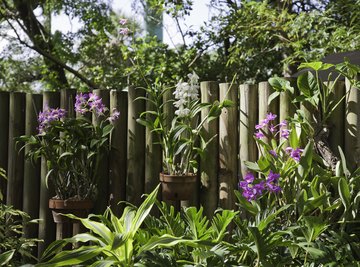
Glucose provides plants with needed food through a process called photosynthesis. This process helps plants convert the energy they take in from sunlight into sugar to help nourish the plant. Photosynthesis occurs when carbon dioxide, water and sunlight are combined. Plants use these to form glucose and oxygen.
Glucose in Photosynthesis
Photosynthesis in plants occurs when a plant gets its energy from light, typically sunlight. Using water and carbon dioxide taken in from the surrounding air, a plant is able to convert these molecules into glucose and oxygen.
The plant then releases oxygen into the air. Glucose, which is actually a sugar, feeds the plant. There are many uses of glucose in plants. Glucose helps plants grow, form flowers and develop fruit. It also helps plants develop seeds.
Plant Leaf Structure
A plant's leaves are designed to retain water. That water then combines with carbon dioxide and light to form glucose to feed the plant. To help the plant retain water, leaves have a cuticle, a wax-like protective coating that prevents water from evaporating.
Leaves also have tiny pores that allow the leaf to take in carbon dioxide. Carbon dioxide is vital to the photosynthesis process the plant needs to form glucose and expel oxygen.
These leaf pores, called stomata, are found on the underside of the leaf. Once the leaf inhales carbon dioxide, the CO2 moves to the leaf's mesophyll cells. This is where photosynthesis takes place and glucose is formed.
Stored Glucose
This all happens when there’s sun. At night, or in winter, the plant is able to store glucose through a process called cellular respiration. Photosynthesis and cellular respiration are how plants and trees can stay dormant through cold, dark winter months and at night.
That stored glucose provides the energy to help many spring bulbs flower. Crocuses, daffodils, hyacinths, tulips and snowdrops all depend on glucose to flower. Lilacs need glucose to grow and bloom. Flowering trees use stored glucose to form their showy blossoms.
Glucose and Respiration
Glucose joins with oxygen in respiration. Glucose and oxygen together produce energy, which helps the plant thrive. Carbon dioxide is one byproduct of the respiration process.
When you plant a seed or young plant, the label will likely say how far away it should be from surrounding plants. That’s because all plants, like all living things, need oxygen.
If your plant is overcrowded or waterlogged from too much rain or poor soil drainage, this can damage or kill your plant. So plants, like people, need space to take in oxygen. Humans and other mammals, however, cannot form glucose in their bodies the way plants can. That’s why people eat plants that contain glucose.
Other Roles for Glucose
Not all glucose is used for respiration. What’s not needed to produce energy for the plant is used for many other purposes. It may be stored in seeds. Glucose molecules together form cellulose, which builds or adds strength to cell walls.
Glucose molecules also form carbohydrates. When combined with nitrates from the soil, glucose will form amino acids. When amino acids join together, they form proteins. So, think of glucose as an important source of carbohydrates and, in the right combination, as part of a protein.
Without glucose, plants won't grow or reproduce.
Circadian Rhythms
Plants actively change their daily circadian rhythms to match the cycle of day and night by measuring the amount of sugars in their cells, according to a study conducted by scientists from the University of Bristol and four other international universities.
These scientists found that plants sense glucose from photosynthesis and adjust their daily body clocks to stay in tune with their environment. This control allows a plant to spread out its energy reserves so it doesn’t starve at night. It also helps the plant detect the change in seasons.
References
About the Author
Karen Gardner is a freelance writer and editor based in Maryland. She has more than 20 years of experience writing and editing health, home and gardening stories.
